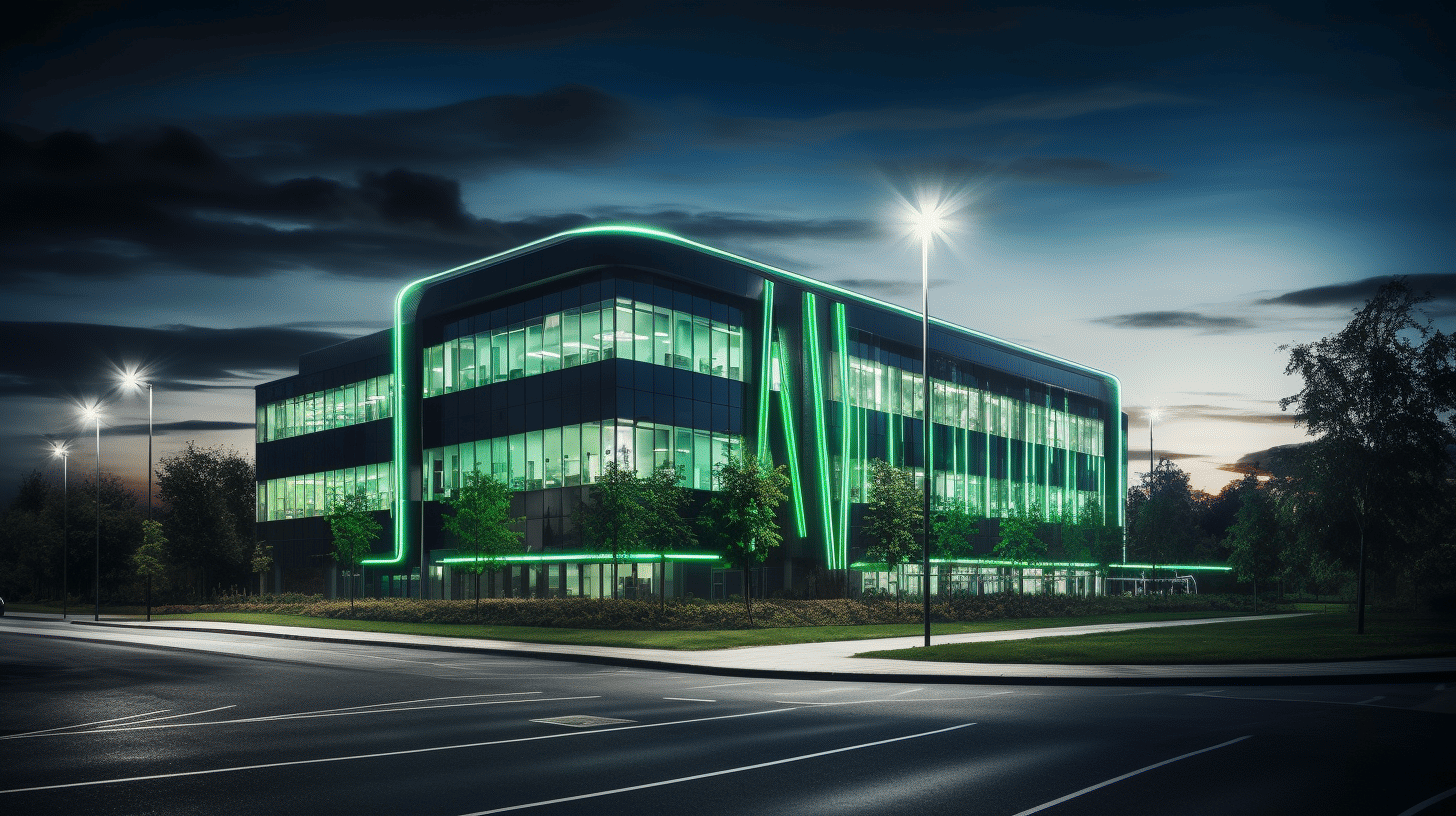Improving Building Infrastructure in the with UPS
Our world is becoming increasingly digitalised, and with this evolution, an ever-growing reliance on steady and reliable electricity has been established. The UK, like most developed nations, is not exempt from this trend. As such, power disruptions in buildings can lead to significant inconveniences and losses. Imagine a day in a commercial building without power - chaotic, right? From office buildings to healthcare facilities, educational institutions, and our own homes, having an uninterrupted power supply has become not just a convenience, but a necessity.
Enter, Uninterruptible Power Supply (UPS) systems - an unsung hero, quietly supporting our modern life by ensuring a consistent flow of power despite outages. Heralded as a game-changer, UPS systems play a vital role in enhancing building infrastructure, leading to increased productivity, better environment sustainability, and, above all, more resilient cities.
Navigating the dynamic landscape of building infrastructure and power management can be complex, but we're here to simplify it for you. So, let's delve into the world of UPS systems, and explore how they can help improve building infrastructure across the UK.

The Current State of Building Infrastructure in the UK
While the UK has been revered for its resilience in handling infrastructural hiccups, the buildings and the underlying structure continue to face significant challenges due to power disruptions. From residential complexes to commercial skyscrapers, the dependence on reliable electric supply is paramount, and any interruption can lead to tangible losses. Let's extend the discussion to grasp a better understanding of these challenges.
Impact of Power Disruptions on the UK Building Infrastructure
Power disruptions greatly impact the UK's building infrastructure. Let's delve a little deeper, shall we?
- Productivity Losses: When power disruptions occur, commercial buildings face a significant loss in productivity. Some sectors are especially vulnerable, like IT companies, which rely heavily on electricity for their operations.
- Increased Operating Costs: Residential buildings also fall prey to these power disruptions. Power outages lead to increased maintenance costs - from unanticipated fixture repairs to the loss of perishables due to prolonged power cuts.
- Infrastructure Damage: Power disruptions can also result in damage to the building's infrastructural elements, like lifts, HVAC systems, fire safety equipment, and more.
These adverse impacts necessitate effective countermeasures to ensure that the skeletal systems of these buildings aren't left at the mercy of power disruptions.
Present Countermeasures against Power Disruptions
Despite the challenges posed by power disruptions, the UK's building infrastructure has implemented measures to mitigate such issues. Below are some noteworthy strategies:
- Backup Power Systems: Many buildings now include emergency power systems within their constructs. These could range from battery-operated inverters to diesel generators that kick in within moments of a power outage.
- Building Automation Systems (BAS): Such systems monitor & control the building's mechanical and electrical equipment, like ventilation, lighting, power systems, fire systems, and security systems. BAS can intelligently manage power consumption and help buildings stay operational during power disruptions.
- Adoption of Renewable Energy Sources: Buildings, especially in urban areas, are now turning towards sustainable power sources like solar panels or wind turbines to reduce their dependence on the traditional power grid.
The current landscape may still not be perfect, but these measures are a stepping stone towards a robust infrastructural framework that can withstand power disruptions. We, therefore, find ourselves in an era of evolution and improvement, working collectively to create a strong, resilient, and sustainable building infrastructure in the UK.
Uninterruptible Power Supply Systems Overview
What is an Uninterruptible Power Supply (UPS)?
Everyone has at some point experienced a power outage, but what if we told you that there was a way to ensure your essential electronic systems never lose power? Welcome to the world of Uninterruptible Power Supply, or UPS as it's more commonly known. UPS systems are like an invisible team working around the clock to protect your critical tools, devices, and appliances from power interruptions.
Compared to standard surge protectors, UPS systems take things a step further. While surge protectors shield your equipment from power surges, a UPS system also provides a temporary power source in the event of a power outage. Essentially, it bridges the gap between mains power and backup generators, ensuring you don't lose essential data or compromise your electronic systems' integrity due to sudden power loss.
The Significance of UPS in a Building's Electrical Infrastructure
Imagine being in a hospital during a power outage without a UPS system. Critical life-supporting machines could be inoperable. Or think of it in an office scenario where the servers go down and tons of unsaved work is lost in an instant. Catastrophic, right?
Well, UPS systems play a critical role in preventing such scenarios. They preserve the continuity of electricity in buildings, providing a seamless transition from the main supply to backup power systems during outages. By doing this, UPS systems protect sensitive electronics that can be critically affected by sudden instabilities in the power supply.
And let's not forget the peace of mind that comes with knowing your systems are protected and can perform optimally, come rain or shine. In the grand scheme of things, UPS systems are one of those few investments that offer priceless returns.
Different Types of UPS Systems
It's worth noting that not all UPS systems are created equal. Your needs and the specific requirements of your environment will often dictate which system is most suitable. Here's a brief look at some common UPS types:
- Standby UPS: This type is also known as Offline UPS, and it mainly offers protection from power drops and surges. In case of a power failure, standby UPS automatically switches to battery-powered DC power
- Line-Interactive UPS: A little more advanced than Standby UPS, this version provides additional features like automatic voltage regulation which makes it suitable for areas with voltage fluctuations
- Double-Conversion On-Line UPS: This style is the Rolls Royce of UPS systems, offering the highest level of protection by continuously converting incoming AC power to DC power, and vice versa. It's ideal for environments that require seamless, high-quality power
To sum up, UPS systems have become an integral part of any electrical infrastructure. They shield your critical tools, devices, and appliances from unforeseen power surges and outages, keeping your operations running smoothly and efficiently. Knowing the importance and different types of UPS systems is beneficial when planning your power backup strategies. After all, life's too short for power interruptions!
The Role of UPS in Enhancing Building Infrastructure in the UK
Building infrastructures have significantly evolved over the years, with innovative technologies escalating their efficiency and sustainability. One crucial development we've seen in this area is the application of uninterruptible power supply (UPS) systems. In the United Kingdom specifically, widespread understanding and acceptance of the role of UPS systems have made them an integral part of the country's building infrastructure.
Reduced Power Disruptions and Increased Productivity
Preventing power disruptions is a crucial objective for any dedicated workforce or sophisticated home system. Consider the business scenario. Every time there's an unexpected power cut, it imposes a direct blow on the momentum of operations. Think about the hassle of restarting computer systems, collecting lost data, or even the mere frustration of being pulled out of 'work mode' abruptly. This is where the UPS comes in.
A UPS system offers continuous power flow to devices by supplying energy from a separate source when the primary power source fails. Isn't it incredible to imagine a working environment free of power-related interruptions?
Here are a few advantages:
- Uninterrupted workflow: Let's face it - work interruptions are frustrating and can hinder productivity. With a UPS system, power cuts won't ever be a headache
- Data security: A sudden power loss can lead to data loss or system crashes. A UPS system reduces the risk by providing enough backup power to save data and safely shut down the computer system
- Enhanced equipment lifespan: Electric faults or power surges can harm your devices. A UPS system can regulate power flow and protect your equipment from premature wear and tear
Support for Critically Powered Facilities
Apart from offices and homes, few facilities are critically powered, meaning a power interruption may result in fatal or hazardous situations. Hospitals, for instance, are dependent on an incessant power supply for essential devices such as life-support machines, crash carts, and surgical lights.
Similarly, data centres require a resilient power source to ensure uninterrupted data flow. A power cut in data centres can lead to server crashes, eventually causing colossal data loss.
Local councils use a UPS system to keep traffic lights operational during power cuts, supporting public safety. Plus, telecom operators also rely on UPS systems to maintain cell tower functions and, consequently, uninterrupted communication.
The integration of UPS systems brings a massive difference here:
- Life preservation: In health facilities, UPS systems save lives. They give technicians enough time for an appropriate response during power failures
- Data protection: For data centres or IT firms, every bit of lost data can mean lost revenue. UPS systems prevent the likelihood of such losses
- Public safety: In public spheres, UPS systems ensure that traffic lights work and maintain public safety during a power outage
So, whether it's keeping our businesses running smoothly, saving lives or protecting data, UPS systems have an undeniable role in enhancing building infrastructure in the UK. They might not be visible or often recognised, but their silent operation is what keeps our world running smoothly, even when things go technically awry. As we strive for more sustainable and resilient infrastructure, UPS systems will continue to be a critical component of that vision.
Environmental Implication of UPS Systems
Uninterrupted Power Supply (UPS) systems have long been considered a standard prerequisite in mission-critical facilities, protecting against the inevitable power disruptions that can hamper productivity and inflict potentially catastrophic damage. However, in an era where environmental conservation is increasingly prioritised, it's essential to understand the ecological implications associated with UPS systems. This article aims to unravel this intricate association, focusing primarily on energy efficiency and the reduction of carbon footprints.
Energy Efficiency
With respect to energy efficiency, modern UPS Systems play an integral part in cutting down unnecessary power consumption. In contrast to older, less efficient models, contemporary UPS systems are engineered to achieve optimal energy performance, thereby reducing overall electricity usage.
The benefits include, but are not limited to:
- Lower energy costs: UPS systems with high-efficiency modes can significantly cut down operational expenses by minimising power waste.
- Longer battery life: By operating more efficiently, these systems use less battery power, which results in extended battery longevity.
- Decreased heat emissions: Efficient UPS systems generate less heat, reducing the workload of air conditioning units, and therefore consuming less energy.
Reduced Carbon Footprint
An exciting aspect of energy-efficient UPS systems is their measurable impact on carbon footprint reduction. By consuming less power, these systems contribute to a noteworthy reduction in greenhouse gas emissions. This helps organisations not only meet regulatory requirements but also make meaningful strides towards sustainability goals.
Consider this, a simple 1% improvement in UPS efficiency can result in a substantial decrease in carbon emissions, aligning with eco-friendly practices adopted globally.
Here's a quick breakdown:
- Environmental sustainability: Energy-efficient UPS systems contribute to a significant reduction in CO2 emissions.
- Regulatory compliance: Businesses can meet and exceed environmental regulations by employing efficient UPS Systems, demonstrating committed environmental stewardship.
- Promotes renewable energy: Integrating UPS systems with renewable resources like solar or wind energy can further help in reducing carbon footprints.
From an environmental perspective, the evolution of UPS systems provides a beacon of hope. Not only do they provide critical protection against power disruptions, they aid in the collective move towards a greener, more sustainable future. As we move forward, embracing technologies that promote environmental sustainability will become critical in our fight against climate change. Indeed, energy-efficient UPS Systems depict a win-win situation, where we can safeguard our operations while also protecting our precious environment.
Applying UPS Systems across Various Building Types in the UK
In today's digital landscape, power failures aren't simply an inconvenience - they can result in catastrophic losses, particularly for certain businesses. Uninterrupted Power Supply (UPS) systems offer a solution to this problem, providing backup power when the main electrical supply fails. As your trusted guide, our task today brings us to the realm of UPS systems and their application across various types of buildings within the UK, from commercial establishments to residential homes and advanced facilities like institutions of learning and healthcare centres.
Commercial Buildings
Commercial buildings, particularly large-scale ones, often require robust power protection due to their high electricity demand. These might include office towers, manufacturing plants, or shopping malls. With UPS systems, there's minimal risk of loss stemming from sudden power outages, which could interrupt critical operations and result in loss of revenue. One of the many reasons commercial buildings embrace UPS systems is due to the following advantages:
- Reduction in downtime – In case of a power outage, UPS systems kick in immediately, preventing interruption of business operations.
- Protect equipment – Commercial buildings house expensive electrical equipment that could get damaged in case of a power surge, which UPS systems protect against.
- Aligning with safety regulations – Ensuring uninterruptible power in commercial buildings aligns with the set safety standards, accentuating the importance of UPS systems.
Residential Buildings
Residential homes may not seem like a typical place for UPS systems. Still, in today's digital age, even the average household relies on power for crucial aspects of their daily life. Imagine losing power in the middle of the night, with your house alarm, heating system, or medical equipment like CPAP machines failing. Here, UPS systems act as an insurance policy against such scenarios, making them increasingly popular in residential buildings.
Educational Facilities
Educational institutes hold a pivotal place in applying UPS systems. These facilities have unique requirements, given the myriad of activities, from computer-based learning to laboratory experiments, all requiring continuous power. Any interruption in the power supply could disrupt these essential activities and threaten the safety of students and staff. Hence, the demand for UPS systems in educational facilities.
Healthcare Facilities
In healthcare facilities, the stakes are even higher. Power outages aren't just an inconvenience - they can be life-threatening. Hospitals, clinics, and nursing homes rely on life-support machines, monitoring equipment, and other medical machines that can't afford a power disruption. As such, UPS systems aren't simply an advantage in these settings; they're a necessity.
We've given you a sneak peek into the world of UPS systems and their application in various building types across the UK. These backup power solutions promise safety, preserve vital functions, and enable smooth operations in times of unexpected power disruptions, making their input invaluable across diverse building structures.
Challenges and Solutions in Integrating UPS Systems in the UK
As experts in Uninterrupted Power Supply (UPS) systems, we understand that installing and maintaining these systems can present certain challenges, particularly in the UK market. Drawing on our wealth of experience, we aim to dissect these issues, focusing specifically on installation, maintenance, and cost challenges. By the end of this section, we'll also suggest some potential solutions to ensure a seamless integration of UPS systems in your business operations.
Installation Challenges
Despite its numerous benefits, installing a UPS system is not always plain sailing. The primary issues in this phase often revolve around:
- Space Considerations: Especially in urban areas where real estate is highly valued, finding enough space for UPS units can be a daunting task.
- Electrical Infrastructure Compatibility: Not all buildings in the UK are designed to support high-powered UPS systems. This can require complex and costly adjustments.
- Safety Regulations: Abiding by the stringent safety norms for electrical installations in the UK also poses significant challenges.
These hurdles don't mean you should shy away from UPS installations. The key lies in preparatory work and choosing the right kind of UPS for your needs.
Maintenance Challenges
Once a UPS system is successfully installed, the pendulum swings to maintenance challenges. Here's what commonly gives owners a pause:
- Skilled Personnel: The need for trained professionals to regularly service the system.
- Spare Parts: Finding the right spare parts for your system can be quite an ordeal.
- Battery Replacement: The average UPS battery life is 3-5 years, and their replacement costs can be quite significant.
Despite these maintenance challenges, the protection a UPS system offers against data loss and equipment failure makes it a worthwhile investment.
Cost Challenges
From installation to maintenance, cost challenges are an overarching theme in the UPS world. In the UK, two main components contribute to these cost struggles:
- High Initial Costs: The hardware required for a UPS system can be quite costly initially.
- Energy Consumption: UPS units often consume large amounts of power, leading to higher energy expenses.
A considered analysis of overall returns on investment, however, can often justify these costs. Remember, the cost of potential outages and equipment damage without a UPS system might be a lot higher than the investment made in one.
Potential Solutions
Facing challenges is an inevitable part of any business operation. The crux of the matter is how to turn these into opportunities. Some suggested solutions to the challenges we've discussed include:
- Tailored Solutions: Choosing a UPS system tailored to your specific power supply needs and premises can dramatically reduce installation challenges.
- Training: Regularly training your staff to handle minor maintenance tasks can significantly reduce the need for expensive professional services.
- Efficient Units: Opt for energy-efficient UPS units to reduce running costs.
Incorporating UPS systems does sound daunting, but the right framework and careful planning can transform this venture into a highly beneficial investment. Plus, the peace of mind of knowing your business continuity is safeguarded. That's priceless.
Conclusion
Implementing Uninterruptible Power Supply (UPS) systems is an assured way of enhancing the resilience and robustness of the UK's building infrastructure. The valuable role they play in reducing power disruptions, ensuring energy efficiency, and supporting critically powered facilities cannot be overstated.
A consistent and reliable power supply is the backbone of any successful operation, whether commercial or residential. With UPS systems integrally woven into a building's electrical framework, we can create an environment of productivity and reliability. However, the path to integrating these systems is not without its challenges, including installation, maintenance, and costs, among others. However, with expertise and planning, these challenges can be adequately navigated.
As a leading provider in the UPS industry, Secure Power takes away the stress and ensures a smooth integration of these systems with its tailored solutions. We are dedicated to providing reliable and efficient power protection solutions for businesses across the UK. With our preventative maintenance packages, regular health checks, and extensive technical knowledge, we are ready to help businesses navigate the intricate demands of electrical frameworks and enjoy the benefits of a reliable UPS system. So, let's work together to power the UK's building infrastructure towards improved reliability and efficiency.
Frequently Asked Questions
-
What is an Uninterruptible Power Supply (UPS) system?
An Uninterruptible Power Supply (UPS) system is a device that provides emergency backup power to electrical systems in the event of a power outage or fluctuation. It ensures uninterrupted power supply to critical equipment and helps prevent data loss and downtime.
-
Why is an Uninterruptible Power Supply system important for building infrastructure in the UK?
An Uninterruptible Power Supply system is crucial for building infrastructure in the UK to ensure continuous operation of essential services, such as hospitals, data centres, transportation systems, and financial institutions, even during power outages or disruptions. It helps maintain productivity and safety and prevents costly damages.
-
What are the main types of Uninterruptible Power Supply systems?
The main types of Uninterruptible Power Supply systems are Offline/Standby UPS, Line Interactive UPS, and Online/Double Conversion UPS. Each type varies in terms of response time, protection level, and efficiency, catering to different applications and requirements.
-
How do I choose the right Uninterruptible Power Supply system for my building infrastructure?
When choosing a Uninterruptible Power Supply system, consider factors such as the power capacity required, battery backup time, UPS topology, scalability, efficiency, management features, and compatibility with your specific infrastructure needs. It's advisable to consult with professionals for a comprehensive assessment and recommendation.
-
Are Uninterruptible Power Supply systems sustainable and energy-efficient?
Yes, modern Uninterruptible Power Supply systems are designed to be more energy-efficient and sustainable. They utilise advanced technologies, such as high-efficiency transformers and energy-saving modes, while reducing carbon footprint. Choosing a green UPS system can contribute to environmental sustainability.














